Text
Essay about Wood block printing
It was my first time to do lino cut prints last year at NQ creative course. Since then, I got really interested in carving.
It’s reminded me that I did a couple of wood carving and wood block print at my primary school which I had great time.
I like doing lino cut prints however, my interest goes to wood block print more than that at the moment. For me, it’s quite difficult to choose the right type of wood boards and materials just now because I have just started but I hope the experience will give me an answer for this later on.
I like the smell of woods and their natural warm texture compare with manmade lino.
Woods are much harder to carve and takes longer time but I am quite patient person so, I even really enjoy these difficulties as well.
Wood block print was invented in China around 700AD.
Since then, this carving wood block method had been the most common in East Asia printing method for printing books, texts and pictures. In fact, now I understand why I am quite familiar with wood block print. As I said earlier, I did a wood block print when I was a child and still used Japanese traditional wood curving tools and baren for the art classes ( It`s a disk like hard tool with a flat bottom and a knotted handle used in Japanese wood block printing. It is used to burnish the back of a sheet of paper lifting ink from the block.)
Woodblock prints are a typical type of relief print. It is called woodcut or xylograph because it uses wood as the original plate.
Ukiyo-e prints are well known all over the world. Ukiyo-e prints are not made by one artist. They are basically and traditionally made by three specialists.
A drawing or painting artist who provided the design image, a wood carve technician and a printer.
I think this fact is really interesting because usually one artist does all these works to create artworks in European countries.
Japanese traditional woodblock printing materials are very unique as well.
For example, we have been using a prunus serrulata (cherry species) wood board as the best quality printing block. Recently, we use plywoods because they are much cheaper.
Traditionally, we use a waterbase paint/shuhi-enogu (mud-pigment)and adding a glue as paints. There are also monochrome printing using only black sumie ink.
Washi paper (traditional Japanese paper) has been used for printing. One especially has a strong quality for rubbing method, this paper is called Ko-zo paper (mulberry paper).Also, before we print on this, it’s very important to damp the paper to get a beautiful result then, put special paint on the board by using a special brush not a roller.
Usually we don't use more than one color on a board. To make one multicolor print, the printer has to print between 5 to 30 times using different boards for the colors.
ARTIST RESEARCH
Kiyoshi Saito (1907-1997)
He was a woodblock printing artist from 20th century in Japan.
Mt.Fuji (1980)
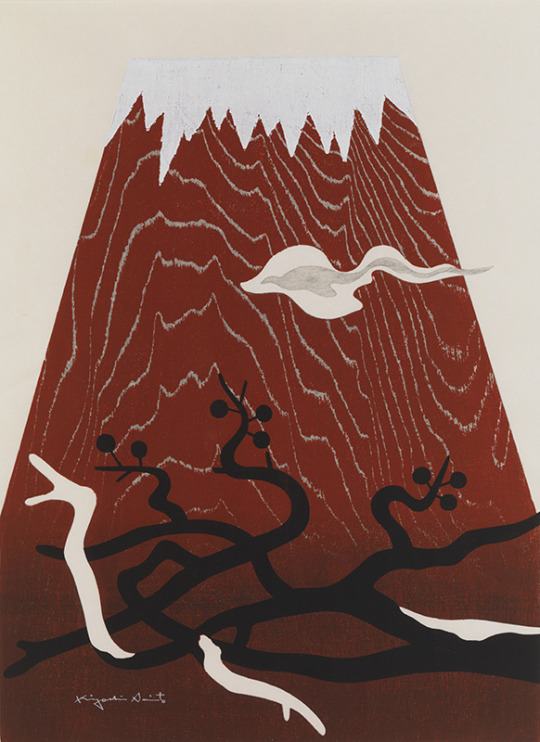
Mt. Fuji has long been respected as a mountain of gods in Japan. Therefore, showing it in artwork must be very respetful and formal for Japanese people.
Normally, Mt.Fuji is shown in blue to express it, but because this one was used red, I think he draw Mt. Fuji as seen in the evening. As the expression aka-fuji in Japanese is used, it depicts Mt. Fuji in a particularly beautiful appearance. Belive or not, you can see this red color Mt.Fuji in real life! Also, this red is not vivid color and uses a very warm natural color.
What is interesting is the color of the sky. It is slightly pink compared to the white snow on the top of the mountain. From that, I think this pale color was intentionally used to make Mt. Fuji, which I admire, stand out. The shape of the clouds looks like a dragon is flying. Even in Japan, it feels like a combination of the myth of a dragon. It's a very proud and elegant movement and in the middle of the cloud, there is a gray blackish line in it. This means this cloud has got a soul in it as well.
Looking at the lower part, a black plum tree that has not yet bloomed is drawn. From this, it can be estimated that the season is between the end of winter to the beginning of spring. Do the white branches represent the snow that has fallen? It looks like it's still in cold weather. Also, the black color is smudged on the bottom parts which means the real world is a dark and terrible place to live but the mountain parts are pure and sacred. It could be meaning of mythology in Japan as well.
The most interesting parts of this work is texture.
He used wooden natural organic woodgrain patterns for the body of mountain. I have never seen a print like this before. It is almost saying this artwork belong to nature world. I think this method will be very useful for my next project.
Clare Leighton (1898-1989)
She was an English-American artist best known for her wood engravings.
Watcher Of The Sky (1955)
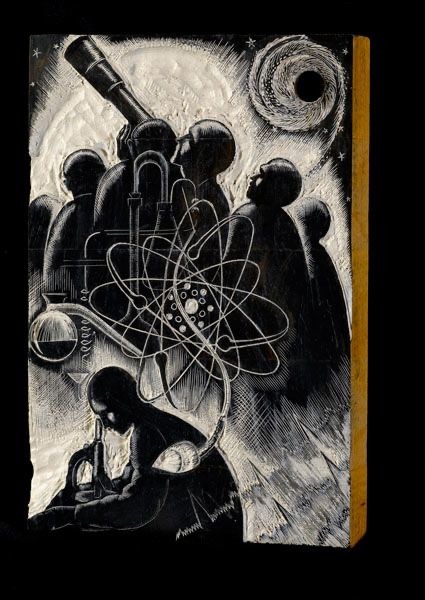
This work is a mixture of realistic and idealised.
Some people are included and I think they are all professional scientists who try to investigate new facts of the sky.
The mysterious shape in the middle and right hand side shows the science of the sky was so mysterious at that time and these scientists are trying very hard to find out the fact or truth. Also, the swirl shape shows confusion inside their head or the hope for a different world.
The color is black and white so it shows the night time and the white color around people look like showing the furure hope to the people.
The bottom right zig zag lines may explain their excitement feelings and cause waves of their heart to pump or could be the sign of universal movements or vibrations.
I found that this is quite scary because not so detailed about people and they are all looking the same direction. Especially, all faces are the same shape and clothes are the same, kinds of very creepy. Maybe wanted show the scientist does not have feeling and they are only interested in the fact. It looks like all people are men. It shows the time of this era, men had more power and access to the education than women. It is very sad and not fair but it was the truth.
They are quite a lot of abstract shapes in this. It is all belong to the scientic world.
Textures are all over the place so there are no plain bit at all on this work makes me a bit breathless and give me emotional pressure.
I think so clever to show the serious and mysterious emotions at the same time on this.
Even thought this is a woodblock print, shows details a lot. Some lines are really straight and the microscope looks real. She is very good at describing the shapes and works are so neat.
Also, I can see the lots of depth in the work almost like an illusion especially on the spiral.
Jed Henry
He is a woodblock print illustrator.
Pocketing a Wager

The most interesting power which he has got is he can change almost all world famous animations or TV programs scenes to Ukiyoe style illustrations. I have never seen before such cool illustrations before. I can not explain well but something old and new are combined together makes really beautiful attractive artworks.
This artwork is about Pokemon and Sumo wrestling.
I can recognize some of characters from Pokemon. All animals look very different from the show but he turn in to them to real Japanese yokai (monster) looking very well. Also he uses Kanji (Japanese character) it makes this piece like it belong to Japanese traditional culture.
I can see the audience in the background but they are not colored just line drawings. It makes the battle scene more powerful and outstanding.
He uses the Japanese traditional paint colors as well. He must study hard to get to know original Ukiyoe very much otherwise it would not work well.
There are no modern items at all in this work. All clothes are kimono, hats and other accessories are also old style.
There is only one bit I can see the modern is the Pikachu`s thunder lines. It is almost like abstract art there which never seen in original Ukiyoe arts. Because of using white lines it is very pale and not overpowering the rest of work.
He did a signature using the alphabet and also used Japanese stamp and the red color really stands out. (we only use red color for this kinds of stamp) It looks very old style but a lot of Japanese people still using this kinds of stamps. ( I have one as well)
So, it makes me want to use my Japanese stamp as signature in the future it would be very unique.
There is not religion a message on this but definitely showing the Japanese traditional culture.
References
www.takezasa.co.jp. (n.d.). 木版印刷による版画制作工程 -摺師の仕事・役割- | 木版印刷・伝統木版画工房 竹笹堂. [online] Available at: https://www.takezasa.co.jp/mokuhan/mokuhan01_3.html [Accessed 8 Mar. 2021].
Wikipedia Contributors (2019). Woodcut. [online] Wikipedia. Available at: https://en.wikipedia.org/wiki/Woodcut. [Accessed 8 Mar. 2021]
武蔵野美術大学 造形ファイル. (n.d.). 武蔵野美術大学 造形ファイル|武蔵野美術大学による、美術とデザインの「素材・道具・技法」に関する情報提供サイト. [online] Available at: http://zokeifile.musabi.ac.jp/. [Accessed 9 Mar. 2021]
ukiyoeheroes.com. (n.d.). Ukiyo-e Heroes | Our Story. [online] Available at: https://ukiyoeheroes.com/about-us.php. [Accessed 10 Mar.2021]
www.clareleighton.com. (n.d.). Clare Leighton. [online] Available at: https://www.clareleighton.com/ [Accessed 10 Mar. 2021].
やないづ町立 斎藤清美術館. (n.d.). ギャラリー. [online] Available at: https://www.town.yanaizu.fukushima.jp/bijutsu/gallery/ [Accessed 10 Mar. 2021].
2 notes
·
View notes
Text
Art analysis
The background of this artwork seems to be the ruins of the Indian countryside because the guy who has got long beard and moustache like old wise man in India or other Asia.
In a mythical or imaginary place, it looks like a wise old man is trying to do something important with his familiar, looks like a lion in a shelter. There is also a human skull next to him probably meaning of death and dark his past or maybe this skull is someone who is really important to him.
There are three phoenixes above them, and I think the circular shape that I thought was the sun at first might represent the phoenix's egg. So, these three phoenixes are waiting some magical new birth is happening soon. For this reason, this work mixes myths and religions. Isn't life and death the main subject? I can feel the really dark feeling from this and also hope for the future.
Despite the work being from 2017, overall it has the emotion of some old tapestries and black-and-white printed matter. If you look at each object, you can see the clouds in the sky, the face of an old man, and the lion are done in the old fashioned llustration style. What seems to be a desk or paper on the lap of an old man is trapezoidal, and the pattern of the rug underneath is very abstract and modern.
Overall, I think this is really interesting artwork for me. It gives me a lot of imagination and feelings.
Japanese version;
このアートワークの背景はインドの田舎の廃墟のように思われます。神話に出てくるような場所で、賢い老人が手慣れしたfamiliar spiritsのライオンとシェルターで何か大事な儀式をしようとしてるように見えます。人間の頭蓋骨もあります。彼らの頭上には3羽の不死鳥がおり、最初は太陽かと思った円形の形はその不死鳥の卵を表してるのではないかと思います。このことから、この作品は神話と宗教を混ぜ合わせて生と死を主な題材としているのではないでしょうか。2017年の作品にも関わらず、全体的に見ると、どこかしら昔のタペストリーや白黒の印刷物に見られる情緒があります。一つ一つのオブジェクトを見ていくと、古い感じがする中にも煉瓦造りの壁には立体的であり、空の雲や老人の顔、ライオンはイラストレーションスタイルが見られます。老人の膝の上にある神と思われるものは台形で下に敷かれてるラグの文様はとてもアブストラクトで現代的な感じもあります。
Alasdair Gray, Saint Jerome, 2017
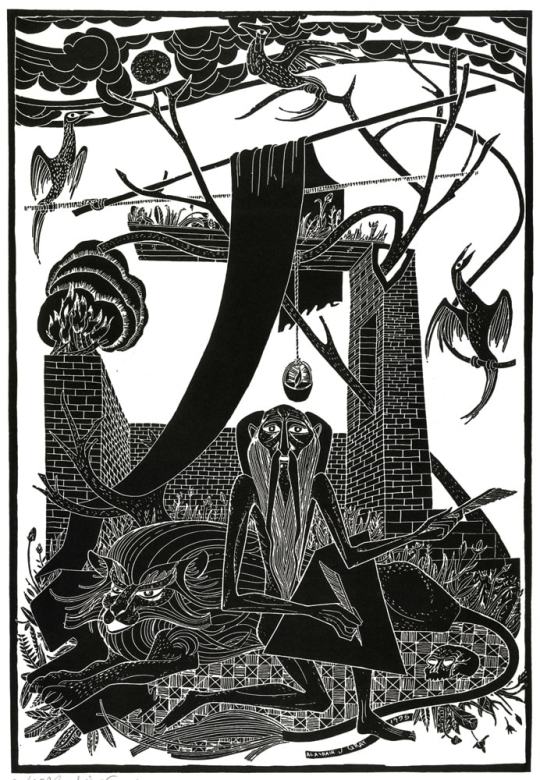
0 notes
Text
Printmaking timeline (500 BCE to 1200AD)
131 BCE worlds first newspaper
Acta Diurna was worlds first news paper invented at Roma.
It was actually not paper which used carved stones or metal boards to show messages such as public notices, announcements and other noteworthy information for public Roman citizens from empire.
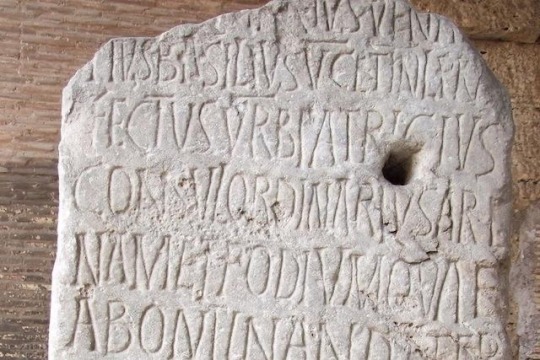
200 AD Paper invented in China
Some people says paper was invented much more earlier than 200AC.
However, the truth is not clear. Before paper, papyrus or animal skins etc...was used since paper invented. To make good or better quality papers they did lots of experiments to mix up different ingredients like hemp, many different kinds of plants, the steam of grasses, vegetables and tree barks.
687AD Oldest European book
Gospel of John the pocket gospel book decorated leather binding was made and it was written in Latin. It was discovered after being closed inside hermit monk’s coffin.
It was beautifully made and written and so tiny as well. The person who made this must have been really artistic person.
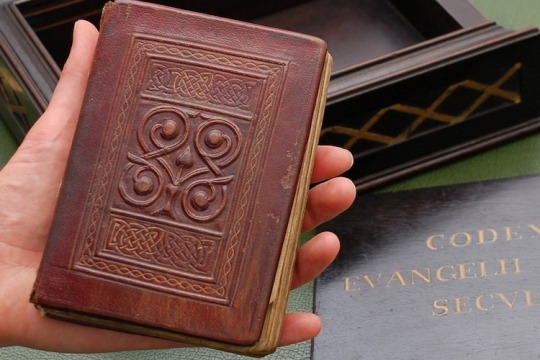
700 AD Wood block print invented in China
Printings used to be ink rubbings text on stone tables for cloth but envolved to this curving wood block method and until 19th century, this is the most common East Asian printing method of printing books and extra texts. (Europe started using this method several centuries later.)
868 AD Oldest dated printed text (Diamond Sutra)
The Diamond Sutra was printed in Dunhuang in China at 868 AC. A block printer created 17 and half foot long scroll of Buddhist text which contains 6000 words. This book was translated to lots of different languages nowadays.

1041 AD Movable type invented
Movable type (typography) which made from baked clay invented in China.
However, in China and Japan which use Kanji writings countries, movable type wasn’t so popular cause of difficulty (alphabet was much fitter for this method) compare with European countries.
1282 AD Water marks were introduced
Water marks were first introduced in Fabriano, Italy. This method was really useful to prevent counterfeiting of stamps, paper moneys and extra.
Printmaking skills made artists easier to duplicate their arts ,too. Instead of doing from scratch again so it was great invention for all over the world.
References;
Wikipedia. (2020). Acta Diurna. [online] Available at: https://en.wikipedia.org/wiki/Acta_Diurna. (Accessed 21 Jan 2021)
www.sutori.com. (n.d.). Sutori. [online] Available at: https://www.sutori.com/item/131-bc-acta-diurna-the-acta-diurna-sometimes-translated-as-daily-public-recor.
(Accessed 21 Jan 2021)
Cartwright, M. (2017). Paper in Ancient China. [online] Ancient History Encyclopedia. Available at: https://www.ancient.eu/article/1120/paper-in-ancient-china/.
(Accessed 21 Jan 2021)
My Modern Met. (2018). Europe’s Oldest Intact Book Is Discovered Inside the Coffin of a Saint. [online] Available at: https://mymodernmet.com/st-cuthbert-gospel-oldest-book/.
(Accessed 23 Jan 2021)
Wikipedia Contributors (2019). Woodblock printing. [online] Wikipedia. Available at: https://en.wikipedia.org/wiki/Woodblock_printing.
(Accessed 23 Jan 2021)
Daley, J. (2016, May 11). Five Things to Know About the Diamond Sutra, the World’s Oldest Dated Printed Book. Retrieved from Smithsonian website: https://www.smithsonianmag.com/smart-news/Five-things-to-know-about-diamond-sutra-worlds-oldest-dated-printed-book-180959052/
(Accessed 23 Jan 2021)
www.historyofinformation.com. (n.d.). The Invention of Movable Type in China : History of Information. [online] Available at: https://www.historyofinformation.com/detail.php?id=19.
(Accessed 23 Jan 2021)
cameo.mfa.org. (n.d.). Watermark - CAMEO. [online] Available at: http://cameo.mfa.org/wiki/Watermark.
(Accessed 23 Jan 2021)
#MB_HNDCPM1
0 notes